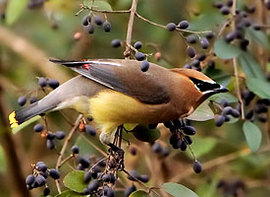Cedar Waxwing (Bombycilla cedrorum)

Description: The Cedar Waxwing is a dark brown bird with a black, mask-like patch
around its black eyes and chin. Its head
is light brown and fades to pale yellow on its belly. The birds wings are mostly black with a tiny
red bar on its secondary wing feathers.
Males and females resemble each other, but young Cedar Waxwings look
slightly different. They have blurry
streaks on their stomachs and light gray heads.
They are only about 6-7 inches long.
Habitat: The Cedar Waxwing prefers to live in habitats including open woodlands, orchards, and residential areas. They breed anywhere from southern Alaska to south to California and Virginia. The birds spend winters in the Great Lakes region and anywhere in New England or southward.
Diet: Cedar waxwings eat sugary fruits and flower petals during the winter. They especially love berries. In the summer, the birds add new things to their diet such as cicadas, caterpillars, beetles, and flies.
Behaviors:
Miscellaneous:
Habitat: The Cedar Waxwing prefers to live in habitats including open woodlands, orchards, and residential areas. They breed anywhere from southern Alaska to south to California and Virginia. The birds spend winters in the Great Lakes region and anywhere in New England or southward.
Diet: Cedar waxwings eat sugary fruits and flower petals during the winter. They especially love berries. In the summer, the birds add new things to their diet such as cicadas, caterpillars, beetles, and flies.
Behaviors:
- Cedar Waxwings are found in flocks throughout the entire year. During the fall and winter, their flocks can be up to thousands in number.
- Cedar Waxwings wander in search of food sources, but they do not demonstrate any typical migration patterns.
- They are monogamous birds who, during courtship, pass food back and forth with their bills.
- Both the male and the female Cedar Waxwings help build the nest, which is a loose cup made of grass, twigs, hair, and bits of bark.
Miscellaneous:
- Cedar waxwings are very sociable creatures but do not have a song
- They make a high-pitched call that sounds like buzzing.
- A group of waxwings are collectively known as an "ear-full" and a "museum" of waxwings.

